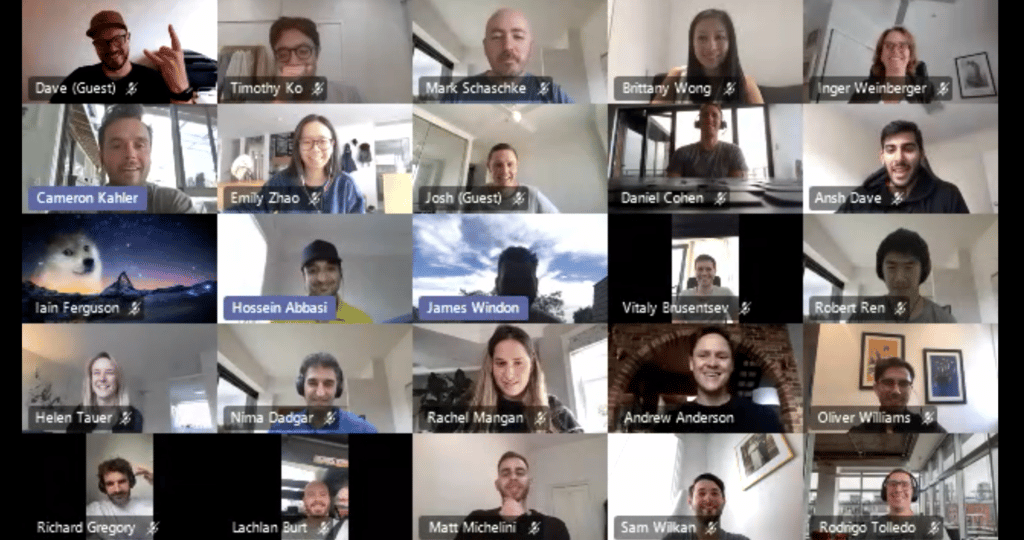Companies are currently at a unique crossroads: for the first time ever, we’re seeing five generations represented in the workforce. While this certainly presents new challenges in the workplace, we also view this as an exciting opportunity to create a cohesive and collaborative multi-generational culture. We’ll explain how in this blog post.
An overview of the five generations in the workplace
Before we dive into our best practices, let’s get familiar with the generations that are currently represented in the workforce. We share a few key points to know about each group below. Keep in mind that these are general observations to help us understand every generation’s big-picture goals, motivations, and needs – and not necessarily an accurate representation of every individual within the demographic.
Generation Z
Employees in this generation, also more casually referred to as Gen-Z, were born between 1995 and 2012 and make up around 5% of the global workforce. Below are a few additional characteristics of this group:
- Are digital natives, but they still tend to prefer face-to-face communication
- Care deeply about doing meaningful work
- Are invested in social issues, such as sustainability, diversity, and climate change
- Has an entrepreneurial spirit and prefers independent work
Millennials
Millennials, also referred to as Generation Y, are comprised of people born between 1980 and 1994. This group currently makes up around 35% of the workforce. Here are a few other things to know about Millennials in the workplace:
- Are very comfortable with technology and prefer to use it at work
- Prefer collaboration and team-oriented companies
- Place a lot of importance on recognition, mentorship, and feedback
- Want to be challenged to grow and aren’t afraid to question authority
Generation X
People from this generation were born between 1965 and 1979 and are also more casually referred to as Gen-X. They currently make up around 33% of the workforce. Below are additional things to know about this generation of workers:
- Prioritise work-life balance
- Value resourcefulness and problem-solving
- Weren’t raised with technology but are still adept at using it
- Thrive in leadership positions and hold over 50% of them
Baby Boomers
This generation is defined by people who were born between 1946 and 1964 and represents around 25% of the workforce. Here are a few other things you should know about Baby Boomers in the workplace:
- Motivated by prestige, promotions, and professional accomplishments
- Value independence and self-reliance
- Enjoy competition and thrive in challenging work environments
- Tend to be goal-driven and disciplined
Silent generation
Employees in the Silent Generation, who are also commonly referred to as Traditionalists, were born between 1928 and 1945. They make up around 2% of the workplace. Below are a few additional characteristics of this group:
- Loyal to their employees and respect authority
- Value stability, security, and consistency
- Hardworking and strong-willed
3 best practices for cross-generational collaboration
1. View differences as strengths, not setbacks
While it’s important to recognize differences between both individuals and groups, these dissimilarities don’t have to be viewed as a setback. Just as HR teams embrace racial and gender diversity, age diversity is something to be welcomed as well. Unfortunately, age isn’t considered among 92% of companies that actually do have diversity hiring strategies in place.
This ultimately impacts your business outcomes. A study found that being a part of a mixed-aged workplace group increased motivation for both older and younger colleagues and increased their intent to stay with the organization. Research also clearly demonstrates that age diversity can improve organizational performance. So whether you’re hosting a company-wide brainstorm or recruiting for new hires, don’t be afraid to cast your net wide.
2. Avoid making general assumptions
It’s easy for people to wave their hands and dismiss Millennials as being “entitled” or criticise the Silent Generation for being “old fashioned.” But these are harmful assumptions that can get in the way of employees forming meaningful relationships with each other. There’s an opportunity for HR teams to step in and steer people away from making these general assumptions.
For example, consider hosting training sessions on the harmful effects of ageism and other similar biases. Or host a group where employees can come together and have an open conversation about the challenges of working in a multi-generational workplace. This is a great way to normalise the topic of ageism instead of tiptoeing around the topic.
3. Encourage cross-generational engagement
It’s easy for employees of similar ages to split up into their own social groups. But you don’t want people getting left out of conversations or bonding time because of this natural tendency to gravitate toward people who look like us. As the HR team, you can encourage employees to connect with others who aren’t necessarily their peers in age.
Consider setting up randomised Donut dates to pair people together. Or host team-oriented activities – like a virtual scavenger hunt or group talent show – and assign people to groups that they likely wouldn’t choose for themselves. While it may take some time, these opportunities will eventually lead to meaningful cross-generational relationships being formed at your organisation.
Managing five generations in the workplace can seem daunting at first. But there are actually tons of benefits to having such a diverse range of ages, perspectives, and experiences represented at your company. Use our best practices to create a culture that embraces multi-generational differences.
To learn how Flare HR’s free onboarding software and employee benefits can strengthen your company culture, request a demo.












